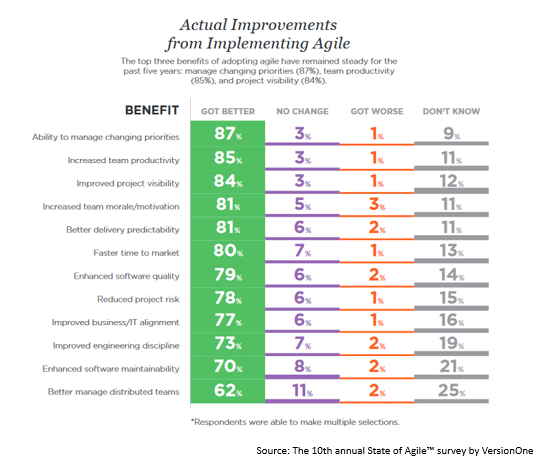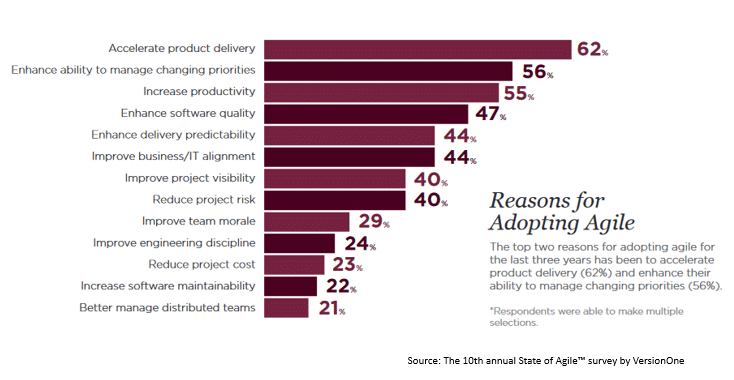Top 10 Reasons for Adopting Agile Software Development Approach
|
Listen on the go!
|
‘Deliver Quality at Speed’ is the success mantra in the current highly competitive digital business world. The traditional approaches for software development divide development and testing into two steps – developers build a feature, and then the QA team tests it for defects. As the product grows, the testing time and efforts also grow exponentially. This throws an unwelcoming choice at the project managers – either to delay the release or to withhold testing.
What is Agile Software Development?
‘Agile’ was born out of the need for a better software development approach that enables developers and testers to reduce the number of bugs in the code and to detect bugs early in the code, respectively. The agile approach helps organizations manage unpredictability while driving collaboration and transparency across teams and adopting a different mindset to be successful. In an agile environment, development cycles break tasks into small increments. It aligns teams to deliver working software more collaboratively and with better quality.
The agile software development approach offers significant benefits to the business—accelerated time to market, better competitive differentiation, and high-quality software that enriches customer satisfaction. Agile software development has grown increasingly popular over the last decade, and the number of organizations, including startups and large enterprises, embracing its benefits continues to increase each year.
Advantages of Agile Development
This blog post gives a quick snapshot of the top 10 advantages and reasons stated in the 10th annual State of Agile™ survey for embracing agile software delivery:
- Accelerate product delivery—The agile development approach enables the enterprise to deliver high-quality software within faster release cycles that are more in line with user needs. An agile development approach involving shorter sprints is gaining momentum to keep up the speed of the development process consistent with the business goals.
- Enhance ability to manage changing priorities —An Agile approach to software development requires teams to develop and test faster and deliver enhancements to the products and services faster to customers. Ensuring that customers’ changes/enhancements are reliable and usable requires taking an agile approach through every step of the project.
- Increase productivity—Organizations need to constantly look for ways to achieve better business outcomes. They require a better way to improve the skills and methodologies that IT staff use to deliver software. The agile approach enables increased productivity through more effective communication while being highly responsive to ever-changing customer demands.
- Enhance software quality—In an agile environment, the development and QA teams cooperate very well and aim to develop software rapidly in close collaboration with the customer. Agile techniques evaluate and enhance software quality while offering increased customer value.
- Enhance delivery predictability—Clients usually care about predictability. They require teams to be good at making and keeping promises and reliably delivering working, tested, and remediated code at the end of each sprint. Without reliable and predictable teams, stable, predictable programs, particularly when multiple dependencies between the teams exist, are impossible. With an agile approach to software delivery, which emphasizes setting up metrics and measurement, teams can plan, coordinate, and deliver with enough predictability and a release-level commitment.
6. Improve business/IT alignment – Organizations need to improve the business and IT alignment to achieve high business value. An organization needs to be efficient and effective to be competitive. The fast changing business environment calls for innovation and agility. Organizations must focus on IT to implement the right systems in the right way to meet the business needs. An organization has to move towards business/IT alignment by focusing on a process to be improved while considering the infrastructure and technology. An agile approach enables all the IT operational processes – Change-Problem-Incidents-IT operations – to be well aligned. Also, it focuses on reduction in time & efforts, and costs & investments in designing, documenting, deployment and testing.
7. Reduce project risk—Agile, as an effective approach for software development, inherently reduces risk. Software development in sprints includes agile techniques such as sprint review, sprint retrospectives, etc. Such techniques provide constant feedback, which helps prevent deviations between expectations and the completed software. With agile, scrum teams prioritize the highest-value and highest-risk requirements first. They use existing agile artifacts and meetings to manage risk.
8. Improve team morale – Agile approach for software development emphasizes on better communication and collaboration among various teams. The very nature of agile approach is to keep the team excited about the challenges ahead. The scrum meetings, prioritization, retrospectives, feedback mechanisms keep the team environment active and happening. Self-organization, seamless communication, treating each member with respect, high collaboration, project visibility to all the stakeholders, etc. which are intrinsic characteristics of agile approach bring positive change and keep the teams motivated. Especially, communication through various forums and discussion boards is at the core of agile approach. Agile approach demands an organization to listen to its employees, communicate its plans to deal with various concerns with employees and recognize employees for their efforts and accomplishments.
9. Improve engineering discipline – The agile principles and practices when adopted and implemented properly, empower the team members to manage and enhance the quality of software rather than just completing the work. The vital component of the high-quality product is always a good and scalable design and architecture. When an organization goes for adopting the agile principles with a goal of delivering a high-quality product, they also should embrace sound engineering discipline. A good design, perfect configuration management, and effective strategies are crucial to making the best use of agility.
Conclusion
We, at Cigniti, employ agile practices for software testing to empower our clients with better business outcomes. We are going to organize a joint webinar with Smartbear on July 20th, 2016 on “Developing a Robust Testing Approach for Agile Transformation.” As part of this webinar, we will primarily focus on the key drivers for moving to an agile process and embrace the benefits of agile development. Do join us for the webinar and learn how organizations can keep pace with emerging agile trends.







Leave a Reply